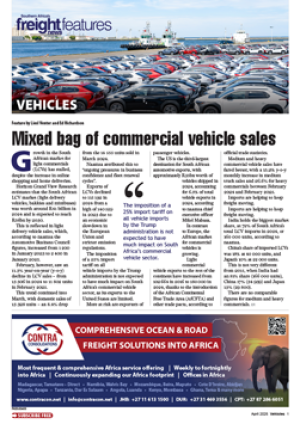'Fundamental' revision from November 1 ALAN PEAT ALTHOUGH THERE was a demand in April from the SA Shippers' Council (SASC) for the Europe South Africa Conference (ESAC) to produce its up-to-now secret formula for the bunker adjustment factor (BAF), the conference has failed to release it. Instead, the conference lines have announced what they term “a fundamental revision” to the method of calculating the bunker surcharge in the trade from November 1. This, ESAC added, is intended to provide “greater transparency”. But, while SASC executive director Nolene Lossau said that shippers always welcomed things which increase transparency, they are not so sure that the information released by the conference actually achieves that end. Base figures Missing from the explanatory documentation are the 1986 base figures for the oil price upon which the calculation is made. In the summary of the method of calculation, the conference identified that MACS and the Southern Africa Europe Container Service (SAECS) were its two vessel-operating bodies. “Each of these groups,” said the summary, “uses two grades of oil to power their vessels - fuel oil (FO) and diesel oil (DO) – and they purchase it from two main ports: Rotterdam and Durban. “The base prices against which the cost of fuel is measured are those from the previous bunker surcharge formula – that is those for the fourth quarter of 1986.” Also, the conference points out that refrigerated (reefer) containers consume more fuel than standard general purpose (GP) containers – and this additional cost is recouped from shippers of reefers. “A weighted average of these variables is calculated, using data supplied by the operating groups,” it said, “and a separate fuel consumption figure for GP and reefer containers is established on a ‘tonnes per twenty-foot equivalent unit (TEU)’ basis.” The bunker surcharge calculation compares the base fuel prices per tonne with the current market prices per tonne for the corresponding grades in each of the review ports. The difference between these two figures is adjusted by the consumption factor for each container type (tonnes of fuel consumed per TEU) to give a US$ figure per TEU. Reviews Reviews of this bunker surcharge, the conference added, will take place quarterly – and the average of thirteen weeks’ review figures (rounded to the nearest whole US$) will be compared to the current surcharge. If the comparison produces a difference (positive or negative) of less than US$5 per TEU, the present figure remains in force. But, if greater than US$5 per TEU, the review figure is announced as the new bunker surcharge. If that’s not complicated enough, the conference adds to the complication by introducing a theoretical exercise which is purely hypothetical. “This,” it said, “uses simple numbers to demonstrate the principles – actual figures will be different.” Its example is: • Base Price - US$80 per tonne; • Current average price (average of 13-weeks) – US$300 per tonne; • Variance - US$220 per tonne; • Tonnes consumed per GP container = 1.2 Per TEU; • Therefore bunker surcharge for GP container = US$220 x 1.2 = US$264 Per GP TEU; • Tonnes consumed per reefer container = 1.3 Per TEU; • Therefore surcharge for reefer container = US$220 x 1.3 = US$286 per reefer TEU.
